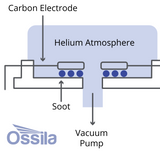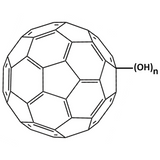Fullerenes for Photovoltaics and Biotechnology
Fullerenes are allotropes of carbon that are closed shells and have a similar structure to footballs / soccer balls. The discovery of buckminsterfullerene, also known as C60 fullerene, sparked the creation of a series of related molecules. Fullerenes have unique properties that make them suitable for use in electronics. Fullerene acceptors, also known as fullerene-based acceptors or acceptor molecules, are a type of electron acceptor material commonly used in conjunction with organic donor materials.
Features of Fullerenes
- Electron acceptance: Fullerenes have excellent electron accepting properties. They readily accept electrons from donor materials. This helps to facilitate efficient charge separation in organic solar cells.
- Solubility: Many fullerene acceptors are soluble in common organic solvents, making them compatible with solution processing techniques, including spin coating.
- High electron mobility: This allows for efficient electron transport within the acceptor material, which is crucial for achieving high device performance.
Explore our fullerenes, soluble fullerene derivatives, and fullerene replacements for electron acceptors in OPV devices and n-type interfaces in perovskite solar cells. Fullerene derivatives, based on the classic fullerenes C60 and C70, are functionalized with chemical groups including phenyls and esters. This makes derivatives like PCBM easier to process within your device.
Jump to: Browse Fullerenes | HOMO and LUMO of Fullerenes | Resources and Support
Browse Fullerenes
Related categories: non-fullerene acceptors, OPV polymers
HOMO and LUMO of Fullerenes
The HOMO and LUMO of fullerenes are crucial factors when selecting components for an electronic device. The LUMO energy level is particularly important for fullerenes used as an acceptor. See the figure below for the (literature) reported HOMO and LUMO levels for our fullerene materials:
Resources and Support
 What are Fullerenes?
What are Fullerenes?
Fullerenes are an allotrope of carbon and are known for their hollow, cage-like structures. They are composed entirely of carbon atoms that form closed, convex polyhedra. The atoms are bonded together to form hexagonal and pentagonal rings, like the pattern found on a soccer ball or geodesic dome.
Read more... Properties of Fullerene
Properties of Fullerene
Fullerene C6o exhibits unique structural, chemical, electronic, and thermal properties. This is due to its highly symmetrical icosahedral structure that contains a mixture of single and double bonds. All fullerenes have partial electron sharing across the molecule and a high affinity for electrons.
Read more... How are Fullerenes Made?
How are Fullerenes Made?
Today, fullerenes are made using three main methods; Huffman-Krätschmer, combustion and microwave. Chemical synthesis techniques, such as laser irradiation and pyrolysis, offer exciting possibilities for producing fullerene derivatives that were previously not accessible.
Read more... Uses of Fullerene and its Derivatives
Uses of Fullerene and its Derivatives
Fullerene and its derivatives are used in chemical, electronic, medicinal, and biological sciences due to their unique physical and chemical properties. Fullerene, also known as C60 or buckminsterfullerene, is a type of carbon allotrope that has properties that can be tuned depending on what it will be used for.
Read more... Water-Soluble Fullerenes: Preparation and Applications
Water-Soluble Fullerenes: Preparation and Applications
Water-soluble fullerenes, such as fullerenol C60, are either chemically modified, polymer grafted, or encapsulated in a hydrophillic agent. Fullerenes can then disperse or solubilize in aqueous media.
Read more... Polymer-Fullerene Bulk Heterojunction Solar Cells
Polymer-Fullerene Bulk Heterojunction Solar Cells
Polymer-fullerene bulk heterojunction (BHJ) solar cells are based on blends of semiconducting polymers and fullerene derivatives, such as PCBM. It is described as a bulk heterojunction as it involves a blend of two materials with differing energy band gaps, forming a dispersed, interpenetrating network.
Read more...






